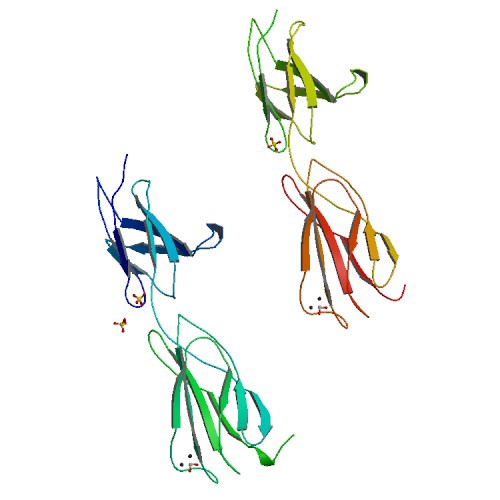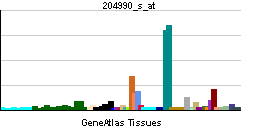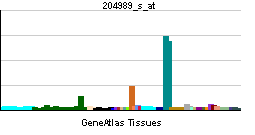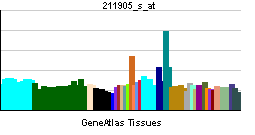ITGB4
| Integrin, beta 4 | |||||||||||||
|---|---|---|---|---|---|---|---|---|---|---|---|---|---|
 PDB rendering based on 1qg3. | |||||||||||||
| |||||||||||||
| Identifiers | |||||||||||||
| Symbols | ITGB4 ; CD104 | ||||||||||||
| External IDs | Template:OMIM5 Template:MGI HomoloGene: 179 | ||||||||||||
| |||||||||||||
| RNA expression pattern | |||||||||||||
 | |||||||||||||
 | |||||||||||||
 | |||||||||||||
| More reference expression data | |||||||||||||
| Orthologs | |||||||||||||
| Template:GNF Ortholog box | |||||||||||||
| Species | Human | Mouse | |||||||||||
| Entrez | n/a | n/a | |||||||||||
| Ensembl | n/a | n/a | |||||||||||
| UniProt | n/a | n/a | |||||||||||
| RefSeq (mRNA) | n/a | n/a | |||||||||||
| RefSeq (protein) | n/a | n/a | |||||||||||
| Location (UCSC) | n/a | n/a | |||||||||||
| PubMed search | n/a | n/a | |||||||||||
Integrin, beta 4 (ITGB4) also known as CD104 (Cluster of Differentiation 104), is a human gene.[1]
Integrins are heterodimers comprised of alpha and beta subunits, that are noncovalently associated transmembrane glycoprotein receptors. Different combinations of alpha and beta polypeptides form complexes that vary in their ligand-binding specificities. Integrins mediate cell-matrix or cell-cell adhesion, and transduced signals that regulate gene expression and cell growth. This gene encodes the integrin beta 4 subunit, a receptor for the laminins. This subunit tends to associate with alpha 6 subunit and is likely to play a pivotal role in the biology of invasive carcinoma. Mutations in this gene are associated with epidermolysis bullosa with pyloric atresia. Multiple alternatively spliced transcript variants encoding distinct isoforms have been found for this gene.[1]
See also
References
Further reading
- Lipscomb EA, Mercurio AM (2006). "Mobilization and activation of a signaling competent alpha6beta4integrin underlies its contribution to carcinoma progression". Cancer Metastasis Rev. 24 (3): 413–23. doi:10.1007/s10555-005-5133-4. PMID 16258729.
- Sonnenberg A, Linders CJ, Modderman PW; et al. (1990). "Integrin recognition of different cell-binding fragments of laminin (P1, E3, E8) and evidence that alpha 6 beta 1 but not alpha 6 beta 4 functions as a major receptor for fragment E8". J. Cell Biol. 110 (6): 2145–55. PMID 1693624.
- Tamura RN, Rozzo C, Starr L; et al. (1990). "Epithelial integrin alpha 6 beta 4: complete primary structure of alpha 6 and variant forms of beta 4". J. Cell Biol. 111 (4): 1593–604. PMID 1976638.
- Hogervorst F, Kuikman I, van Kessel AG, Sonnenberg A (1991). "Molecular cloning of the human alpha 6 integrin subunit. Alternative splicing of alpha 6 mRNA and chromosomal localization of the alpha 6 and beta 4 genes". Eur. J. Biochem. 199 (2): 425–33. PMID 2070796.
- Vogel BE, Tarone G, Giancotti FG; et al. (1990). "A novel fibronectin receptor with an unexpected subunit composition (alpha v beta 1)". J. Biol. Chem. 265 (11): 5934–7. PMID 2138612.
- Suzuki S, Naitoh Y (1990). "Amino acid sequence of a novel integrin beta 4 subunit and primary expression of the mRNA in epithelial cells". EMBO J. 9 (3): 757–63. PMID 2311577.
- Hogervorst F, Kuikman I, von dem Borne AE, Sonnenberg A (1990). "Cloning and sequence analysis of beta-4 cDNA: an integrin subunit that contains a unique 118 kd cytoplasmic domain". EMBO J. 9 (3): 765–70. PMID 2311578.
- Kajiji S, Tamura RN, Quaranta V (1989). "A novel integrin (alpha E beta 4) from human epithelial cells suggests a fourth family of integrin adhesion receptors". EMBO J. 8 (3): 673–80. PMID 2542022.
- Hemler ME, Crouse C, Sonnenberg A (1989). "Association of the VLA alpha 6 subunit with a novel protein. A possible alternative to the common VLA beta 1 subunit on certain cell lines". J. Biol. Chem. 264 (11): 6529–35. PMID 2649503.
- Vidal F, Aberdam D, Miquel C; et al. (1995). "Integrin beta 4 mutations associated with junctional epidermolysis bullosa with pyloric atresia". Nat. Genet. 10 (2): 229–34. doi:10.1038/ng0695-229. PMID 7545057.
- Mainiero F, Pepe A, Wary KK; et al. (1995). "Signal transduction by the alpha 6 beta 4 integrin: distinct beta 4 subunit sites mediate recruitment of Shc/Grb2 and association with the cytoskeleton of hemidesmosomes". EMBO J. 14 (18): 4470–81. PMID 7556090.
- Clarke AS, Lotz MM, Mercurio AM (1995). "A novel structural variant of the human beta 4 integrin cDNA". Cell Adhes. Commun. 2 (1): 1–6. PMID 7982032.
- Weeks BS, Desai K, Loewenstein PM; et al. (1993). "Identification of a novel cell attachment domain in the HIV-1 Tat protein and its 90-kDa cell surface binding protein". J. Biol. Chem. 268 (7): 5279–84. PMID 8444901.
- Iacovacci S, Gagnoux-Palacios L, Zambruno G; et al. (1997). "Genomic organization of the human integrin beta4 gene". Mamm. Genome. 8 (6): 448–50. PMID 9166594.
- Mainiero F, Murgia C, Wary KK; et al. (1997). "The coupling of alpha6beta4 integrin to Ras-MAP kinase pathways mediated by Shc controls keratinocyte proliferation". EMBO J. 16 (9): 2365–75. doi:10.1093/emboj/16.9.2365. PMID 9171350.
- Pulkkinen L, Kurtz K, Xu Y; et al. (1997). "Genomic organization of the integrin beta 4 gene (ITGB4): a homozygous splice-site mutation in a patient with junctional epidermolysis bullosa associated with pyloric atresia". Lab. Invest. 76 (6): 823–33. PMID 9194858.
- van Leusden MR, Kuikman I, Sonnenberg A (1997). "The unique cytoplasmic domain of the human integrin variant beta4E is produced by partial retention of intronic sequences". Biochem. Biophys. Res. Commun. 235 (3): 826–30. doi:10.1006/bbrc.1997.6892. PMID 9207246.
- von Bredow DC, Nagle RB, Bowden GT, Cress AE (1997). "Cleavage of beta 4 integrin by matrilysin". Exp. Cell Res. 236 (1): 341–5. doi:10.1006/excr.1997.3711. PMID 9344615.
- Biffo S, Sanvito F, Costa S; et al. (1997). "Isolation of a novel beta4 integrin-binding protein (p27(BBP)) highly expressed in epithelial cells". J. Biol. Chem. 272 (48): 30314–21. PMID 9374518.
- Pulkkinen L, Kim DU, Uitto J (1998). "Epidermolysis bullosa with pyloric atresia: novel mutations in the beta4 integrin gene (ITGB4)". Am. J. Pathol. 152 (1): 157–66. PMID 9422533.
External links
- ITGB4+protein,+human at the US National Library of Medicine Medical Subject Headings (MeSH)
| Stub icon | This membrane protein–related article is a stub. You can help Wikipedia by expanding it. |
This article incorporates text from the United States National Library of Medicine, which is in the public domain.